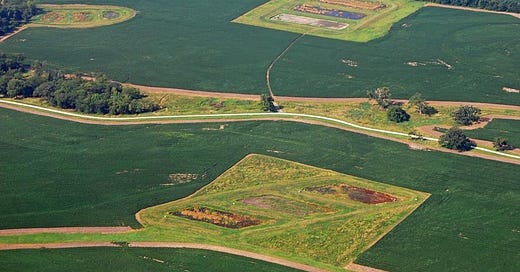BRB w/ Nathan P – Wetlands, Tofu Katsu Curry & The Five Dysfunctions of a Team
How small wetlands reduce agricultural runoff, a veggie Japanese dream come true, and 5 tips on cultivating excellent teams (#29).
Hi all,
Welcome back to BRB w/ Nathan P, a weekly newsletter featuring 💥1 Breakthrough, 🥘1 Recipe, and 📚1 Book on food & climate.
Before we get started, here are highlights of food & climate in the news this week:
Free food: Geneva’s community pantries use the sharing economy to prevent food waste (EuroNews)
A giant water battery inside a mountain will help Scotland hit net zero (EuroNews)
💥 Breakthrough: Wetlands
I know what you’re thinking: wetlands are not exactly the sexiest climate tech breakthrough.
But they are a proven natural solution to a hard-to-solve environmental challenge: agricultural run-off.
Industrial agriculture uses tons of synthetic fertilizer. This concoction of nitrogen, phosphorus, and other nutrients is largely a by-product from fossil fuels.
Agricultural run-off is difficult to solve because it is a non-point source coming from many directions. The nutrients from fertilizer that escape fields can have dangerous consequences, as they:
🚿 Contaminate drinking water
🌊 Kill marine ecosystems
💨 Release tons of nitrous oxide into the air
Only half of the nitrogen in synthetic fertilizers is absorbed by the soil. The other half is runoff, or is emitted as nitrous oxide. Nitrous oxide has 265X the warming potential of CO2.
Agricultural runoff reaches rivers and eventually oceans, causing “dead zones” like the one in the Gulf of Mexico. High influx of nitrogen and phosphorus causes algae levels to spike, depriving oxygen from marine life until the areas are unlivable.
Wetlands are a proven, low-tech, and cost-effective solution. In 2005, The Nature Conservancy started an experiment on farms in Illinois to determine if wetlands could help reduce agricultural runoff.
On a 140-acre farm, they created 3 wetland plots that only accounted for 6% of the territory. Here is what they learned:
💦 Wetlands reduce water pollution: they can capture over 50% of excess nitrogen and phosphorus
🌱 Small wetlands can have a big impact: the water pollution reduction was achieved with only 6% of the land area
🦐 Positive impact on the Gulf of Mexico: the removal of excess nutrients decreases algae growth, giving more oxygen to marine wildlife
The plants and microbes in the wetlands absorb these nutrients, converting them into biomass and nitrogen gas. These impressive feats take only a few percentages of the land area, ensuring as much as possible can remain focused on food production.
Wetlands not only solve the agricultural runoff problem. They also increase local biodiversity and sequester massive amounts of carbon, often 10X more than agricultural soil.
Wetlands are a key nature-based solution. However, it’s not yet obvious how they can be scaled. Farmers may be reluctant to relinquish land; start-ups may struggle to find a viable business case; governments may have other environmental priorities.
There could be a viable business case through carbon credits and nutrient valorization. In any case, these initiatives will need creative financing, engineering, and execution across public and private partnerships.
🥘 Recipe: Tofu Katsu Curry
It’s crunchy, it’s juicy, and it’s guilt-free: tofu katsu curry (say that three times fast).
It’s one of my favorite lunch options, and I’d recommend going with organic extra firm sprouted tofu.
Scroll down for the recipe.
If you make it, please send pictures :)
📚 Book: The Five Dysfunctions of a Team
Successful climate action requires great teamwork. We’re going to need new innovations, systems, and products – all in an unprecedented amount of time.
The Five Dysfunctions of a Team by Patrick Lencioni is a guide on cultivating great teams. Whether you are a start-up founder, corporate executive, or team member, this book is for you.
Many founders already know that technology, fundraising, and IP do not guarantee start-up success. It’s often through quality teams aligned towards a common goal.
This book breaks down the 5 dysfunctions that make teams fall apart, and highlights how to address each before it’s too late.
As a synopsis, here are the 5 dysfunctions to address:
Absence of trust: this can be overcome by fostering great communication and eliminating team members’ need for invulnerability.
Fear of conflict: when team members are more concerned about how their words are perceived rather than speaking the truth, it makes it difficult to find core issues and align on the solutions.
Lack of commitment: all team members need to weigh-in before they can buy-in, they need to be involved in decision-making to have ownership over decisions.
Avoidance of accountability: team leaders and executives provide honest feedback to their direct reports, but often avoid doing the same for their peers when they need to make changes.
Inattention to results: when teams cannot align on the right key priority (singular) of the company, they do not achieve meaningful results.
Thank you for reading – BRB next week ✌️
🥘 Recipe: Tofu Katsu Curry
Ingredients:
Sauce
1 onion
4 garlic cloves
2 carrots
Inch of ginger
1 tbsp curry powder
1/4 tsp ground turmeric
1/2 tsp garam masala
1 tbsp mirin (or maple syrup)
2 tbsp soy sauce
1 tbsp tomato puree
550ml vegetable stock
Tofu
550g sprouted extra firm tofu (organic)
2 tbsp plain flour
50ml unsweetned almond milk
1 cup panko breadcrumbs
Salt and pepper
To serve
Rice of choice (sushi, basmati, brown)
2 spring onion
Fresh coriander
Instructions:
Heat a tbsp of oil in a large frying pan on medium heat. Finely dice the onion and add.
Stir and let cook for a few minutes, then add the crushed garlic, grated ginger and peeled and sliced carrot.
Let this cook for 5 minutes then add the curry powder, garam masala and turmeric. Stir and cook for a further minute.
Add the mirin, soy sauce, tomato puree and vegetable stock and leave to simmer for 10-15 minutes. The carrot should be soft.
Transfer to a blender or use a hand blender to blitz until smooth, around 30 seconds.
Place it back in the pan on a low heat and leave for later. If you want the sauce a bit thinner, add some extra water.
In three separate bowls place the flour, milk and breadcrumbs. Season the breadcrumbs with some salt and pepper.
Cut the tofu into 4 slices so they are rectangular in shape. Use a paper towel to pat them dry.
Place the tofu into the flour, then the milk and lastly the breadcrumbs. Make sure they are well coated at every stage. Gently shake off excess breadcrumbs and place to the side until each tofu slice is coated.
In a frying pan add 2-3 tbsp vegetable oil on medium-high heat. Once hot, place the breaded tofu in, one or two at a time depending on the size of your pan. Fry on each side for a few minutes until golden brown. To fry the sides, use some tongs to carefully flip the tofu onto its side until golden brown all over. Place on some kitchen paper to soak up any excess oil.
Whilst the tofu is cooking, cook the rice according to packet instructions.
Slice the breaded tofu diagonally using a sharp knife and serve with the rice and curry sauce.
Top with some fresh coriander, sliced spring onion and a side salad. Enjoy with your besties :)
About Me
Hi there! My name is Nathan Paumier - I’m an avid reader, food enthusiast, and climate optimist. I started this newsletter after frequent questions on food tech, reading recommendations, and my secret recipes.
Want to get in touch or chat further? Anything you’d like to hear more of?
Forwarded this email?
Subscribe below to receive an email from me every week.
No spam, just quality ingredients.








